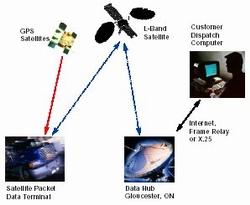Sun, May 16, 2010
Sky Connect Flight-Following Equipment One Key To Battling
Wildfires More Effectively
 Flight-following technology from EMS Aviation shared the
spotlight with California Governor Arnold Schwarzenegger May 3, as
he watched a real-time demonstration of the state’s new
aircraft tracking system technology. The governor also signed an
Executive Order mobilizing the California Department of Forestry
and Fire Protection (CAL FIRE) to be prepared and vigilant as the
state approaches peak fire season.
Flight-following technology from EMS Aviation shared the
spotlight with California Governor Arnold Schwarzenegger May 3, as
he watched a real-time demonstration of the state’s new
aircraft tracking system technology. The governor also signed an
Executive Order mobilizing the California Department of Forestry
and Fire Protection (CAL FIRE) to be prepared and vigilant as the
state approaches peak fire season.
EMS Aviation said in a news release Thursday that it has
delivered 20 of 66 Automatic Flight-Following (AFF) systems to CAL
FIRE, and 17 systems are in operation. CAL FIRE plans to equip its
fleet of 53 fixed-wing and rotary-wing aircraft with AFF systems by
June, according to Chief Del Walters, CAL FIRE director. EMS
Aviation is the world’s leading provider of Iridium-based
voice and tracking systems for aircraft.
The governor told an assembled crowd that equipping the CAL FIRE
fleet with flight-following technology is one way the state will
maximize its firefighting capabilities. “We need every tool
at our disposal. This year, for the first time, we will employ
special GPS technology to track aircraft for more rapid and
efficient response to wildfires,” he said. “We will not
be caught off-guard or under-equipped.”

Walters agreed that the EMS Aviation systems help CAL FIRE
deploy its firefighting aircraft more efficiently. “Not only
will we know where the aircraft are, we’ll know where they
are in relation to an emerging incident, so we’ll know the
fastest tool to dispatch.” On average, CAL FIRE responds to
5,000 wildfires a year. Last year the agency responded to 7,000
incidents.
“We believe having the latest in tracking technology will
be increasingly important as states like California see intensified
and extended fire-fighting seasons. We hope to build on this
strategic relationship with CAL FIRE to showcase how real-time
position-reporting can help other states and countries manage their
fire-fighting resources effectively,” said Nim Evatt, vice
president and general manager of EMS Aviation.
When an aircraft is equipped with AFF, dispatchers are regularly
updated on its position and flight status with no active pilot
input. Reporting intervals are generally every two minutes but may
be customized based on operator preference. Flight data is also
recorded, and the information collected is instrumental in case of
an accident or incident. Aircraft must be equipped with AFF in
order to be considered for government contracts in the U.S. and
Canada.
More News
“These new aircraft strengthen our ability to respond quickly, train effectively and support communities nationwide. Textron Aviation has been a steadfast supporter in helpin>[...]
From 2011 (YouTube Edition): Rugged, Legendary, STOL Twin Makes A Comeback The de Havilland Twin Otter is an airplane with a long history, and it gained a reputation as a workhorse>[...]
A Wind Gust Lifted The Right Wing And The Airplane Turned To The Left Analysis: The pilot was departing from a 2,395-ft-long by 50-ft-wide turf runway. The pilot reported that afte>[...]
Have A Story That NEEDS To Be Featured On Aero-News? Here’s How To Submit A Story To Our Team Some of the greatest new stories ANN has ever covered have been submitted by our>[...]
Braking Action Advisories When tower controllers receive runway braking action reports which include the terms “medium," “poor," or “nil," or whenever weather con>[...]
 Aero-News: Quote of the Day (12.18.25)
Aero-News: Quote of the Day (12.18.25) Classic Aero-TV: Viking Twin Otter 400--Bringing the DHC-6 Back Into Production
Classic Aero-TV: Viking Twin Otter 400--Bringing the DHC-6 Back Into Production NTSB Final Report: Rans Employee Flying Club Rans S-6ES Coyote II
NTSB Final Report: Rans Employee Flying Club Rans S-6ES Coyote II ANN FAQ: Submit a News Story!
ANN FAQ: Submit a News Story! ANN's Daily Aero-Term (12.18.25): Braking Action Advisories
ANN's Daily Aero-Term (12.18.25): Braking Action Advisories




